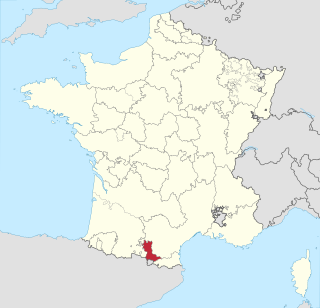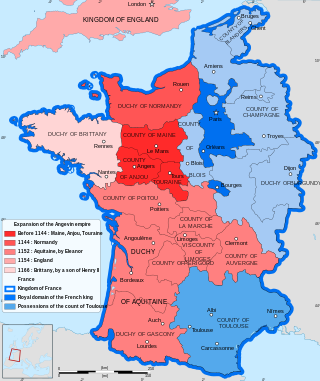These are lists of political office-holders in France.
The County of Armagnac, situated between the Adour and Garonne rivers in the lower foothills of the Pyrenées, was a historic county of the Duchy of Gascony, established in 601 in Aquitaine. In 960, the title of 'Count of Armagnac' was established, and thus the County of Armagnac was created. In 1751, following the death of childless Charles de Lorraine, Comte d'Armagnac, the county was absorbed into the Crown lands of France and the King, then Louis XV took the title of 'Count of Armagnac'. In 1791, following the Decree dividing France into departments, the county was disestablished, but remains an important natural region of France.

The County of Foix was an independent medieval fief in southern France, and later a province of France, whose territory corresponded roughly the eastern part of the modern département of Ariège.
Duke of Nemours was a title in the Peerage of France. The name refers to Nemours in the Île-de-France region of north-central France.

The County of La Marche was a medieval French county, approximately corresponding to the modern département of Creuse and the northern half of Haute Vienne.

Bernard VII, Count of Armagnac was Count of Armagnac and Constable of France. He was the son of John II, Count of Armagnac, and Jeanne de Périgord. He succeeded in Armagnac at the death of his brother, John III, in 1391. After prolonged fighting, he also became Count of Comminges in 1412.

Jacques d'Armagnac, duke of Nemours, was the son of Bernard d'Armagnac, count of Pardiac, and Eleanor of Bourbon-La Marche.
William García was a Count of Fézensac. He was the second son of García II of Gascony and Amuna.
The County of Fézensac was an 8th-century creation on the north-eastern fringes of the Duchy of Gascony following Charlemagne's policy of feudalisation and Frankish colonisation. The move was aimed at offsetting and undermining the authority of the duke of Gascony Lupo II after the setback suffered by the Franks at the Battle of Roncevaux in 778 and failure to restrain the Basques. That advance clearly displeased the Basques, with these policies sparking a stir on the banks of the Garonne.

John I of Armagnac, son of Bernard VI and Cecilia Rodez, was Count of Armagnac from 1319 to 1373. In addition to Armagnac he controlled territory in Quercy, Rouergue and Gévaudan. He was the count who initiated the 14th century expansion of the county.
John IV was a Count of Armagnac, Fézensac, and Rodez from 1418 to 1450. He was involved in the intrigues related to the Hundred Years' War and in conflicts against the King of France.
The Count of Pardiac was a title in the French nobility.
The crown lands, crown estate, royal domain or domaine royal of France were the lands, fiefs and rights directly possessed by the kings of France. While the term eventually came to refer to a territorial unit, the royal domain originally referred to the network of "castles, villages and estates, forests, towns, religious houses and bishoprics, and the rights of justice, tolls and taxes" effectively held by the king or under his domination. In terms of territory, before the reign of Henry IV, the domaine royal did not encompass the entirety of the territory of the kingdom of France and for much of the Middle Ages significant portions of the kingdom were the direct possessions of other feudal lords.
Castres-en-Albigenses was a dependence of the Viscount of Albi. The Viscounts of Albi granted Castres a city charter establishing a commune with the city, headed by consuls. During the Albigensian Crusade, the city quickly surrendered to Simon de Montfort, who gave it to his brother Guy de Montfort.
John II, the Hunchback,, Count of Armagnac, of Fézensac, Rodez (1371–1384) and Count of Charolais (1364–1384), Viscount Lomagne and Auvillars, he was the son of John I, Count of Armagnac, of Fezensac and Rodez, Viscount Lomagne and Auvillars and Beatrix de Clermont, great-granddaughter of Louis IX of France.
Charles d'Armagnac, born 1425, died June 3, 1497, in Castelnau-de-Montmiral at the age of 72 years, was Count of Armagnac and Rodez from 1473 to 1497. He was the son of John IV, Count of Armagnac and Rodez, and Isabella d'Évreux. His older brother, Count John V, was a leader of the League of the Public Weal against King Louis XI of France, causing Charles to be imprisoned for fifteen years. John was killed in a skirmish, allowing Charles to inherit the title of Count of Armagnac.

Bernard VI,, Count of Armagnac and Fezensac, was the son of Gerald VI, Count of Armagnac, and Mathe de Béarn.
Gerald V d'Armagnac, Count of Armagnac and Fézensac from 1215 to 1219, was the son of Bernard d'Armagnac, Viscount of Fézensaguet and Geralda of Foix.
Bernard d'Armagnac (1155–1202) was Lord of Firmacon then Viscount of Fezensaguet from 1182 to 1202. He was the son of Gerald, Count of Armagnac.
Roger I Armagnac was Viscount of Fezensaguet. He was the son of Bernard I, Viscount of Fezensaguet and Lomagne, and Geralda de Foix.








